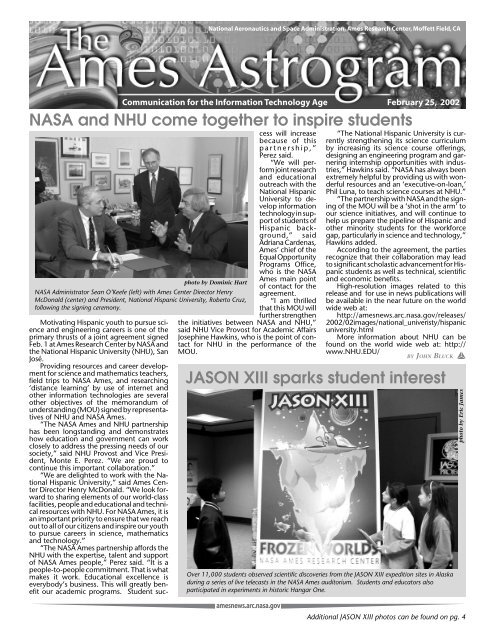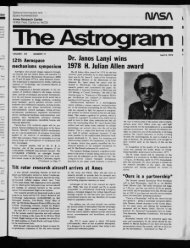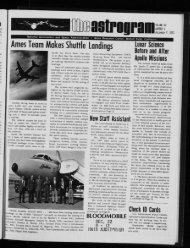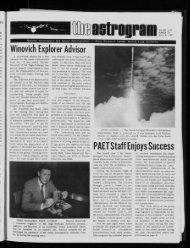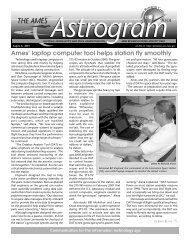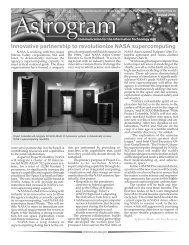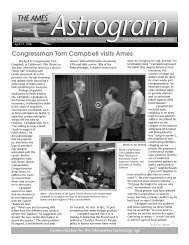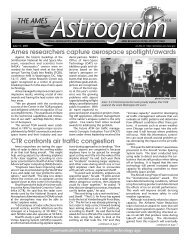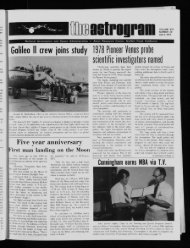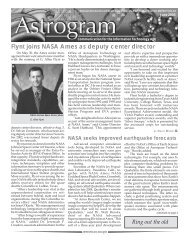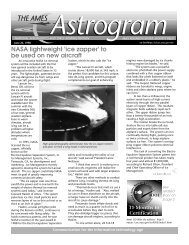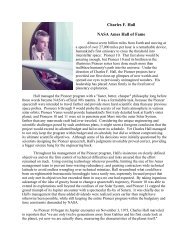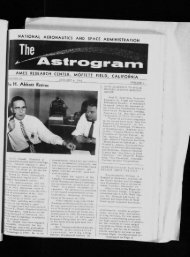2002 February 25 - NASA Ames History Office
2002 February 25 - NASA Ames History Office
2002 February 25 - NASA Ames History Office
Create successful ePaper yourself
Turn your PDF publications into a flip-book with our unique Google optimized e-Paper software.
National Aeronautics and Space Administration, <strong>Ames</strong> Research Center, Moffett Field, CA<br />
Communication for the Information Technology Age <strong>February</strong> <strong>25</strong>, <strong>2002</strong><br />
<strong>NASA</strong> and NHU come together to inspire students<br />
photo by Dominic Hart<br />
<strong>NASA</strong> Administrator Sean O’Keefe (left) with <strong>Ames</strong> Center Director Henry<br />
McDonald (center) and President, National Hispanic University, Roberto Cruz,<br />
following the signing ceremony.<br />
Motivating Hispanic youth to pursue science<br />
and engineering careers is one of the<br />
primary thrusts of a joint agreement signed<br />
Feb. 1 at <strong>Ames</strong> Research Center by <strong>NASA</strong> and<br />
the National Hispanic University (NHU), San<br />
José. Providing resources and career development<br />
for science and mathematics teachers,<br />
field trips to <strong>NASA</strong> <strong>Ames</strong>, and researching<br />
‘distance learning’ by use of internet and<br />
other information technologies are several<br />
other objectives of the memorandum of<br />
understanding (MOU) signed by representatives<br />
of NHU and <strong>NASA</strong> <strong>Ames</strong>.<br />
“The <strong>NASA</strong> <strong>Ames</strong> and NHU partnership<br />
has been longstanding and demonstrates<br />
how education and government can work<br />
closely to address the pressing needs of our<br />
society,” said NHU Provost and Vice President,<br />
Monte E. Perez. “We are proud to<br />
continue this important collaboration.”<br />
“We are delighted to work with the National<br />
Hispanic University,” said <strong>Ames</strong> Center<br />
Director Henry McDonald. “We look forward<br />
to sharing elements of our world-class<br />
facilities, people and educational and technical<br />
resources with NHU. For <strong>NASA</strong> <strong>Ames</strong>, it is<br />
an important priority to ensure that we reach<br />
out to all of our citizens and inspire our youth<br />
to pursue careers in science, mathematics<br />
and technology.”<br />
“The <strong>NASA</strong> <strong>Ames</strong> partnership affords the<br />
NHU with the expertise, talent and support<br />
of <strong>NASA</strong> <strong>Ames</strong> people,” Perez said. “It is a<br />
people-to-people commitment. That is what<br />
makes it work. Educational excellence is<br />
everybody’s business. This will greatly benefit<br />
our academic programs. Student suc-<br />
JASON XIII sparks student interest<br />
Over 11,000 students observed scientific discoveries from the JASON XIII expedition sites in Alaska<br />
during a series of live telecasts in the <strong>NASA</strong> <strong>Ames</strong> auditorium. Students and educators also<br />
participated in experiments in historic Hangar One.<br />
amesnews.arc.nasa.gov<br />
cess will increase<br />
because of this<br />
partnership,”<br />
Perez said.<br />
“We will perform<br />
joint research<br />
and educational<br />
outreach with the<br />
National Hispanic<br />
University to develop<br />
information<br />
technology in support<br />
of students of<br />
Hispanic background,”<br />
said<br />
Adriana Cardenas,<br />
<strong>Ames</strong>’ chief of the<br />
Equal Opportunity<br />
Programs <strong>Office</strong>,<br />
who is the <strong>NASA</strong><br />
<strong>Ames</strong> main point<br />
of contact for the<br />
agreement.<br />
“I am thrilled<br />
that this MOU will<br />
further strengthen<br />
the initiatives between <strong>NASA</strong> and NHU,”<br />
said NHU Vice Provost for Academic Affairs<br />
Josephine Hawkins, who is the point of contact<br />
for NHU in the performance of the<br />
MOU.<br />
“The National Hispanic University is currently<br />
strengthening its science curriculum<br />
by increasing its science course offerings,<br />
designing an engineering program and garnering<br />
internship opportunities with industries,”<br />
Hawkins said. “<strong>NASA</strong> has always been<br />
extremely helpful by providing us with wonderful<br />
resources and an ‘executive-on-loan,’<br />
Phil Luna, to teach science courses at NHU.”<br />
“The partnership with <strong>NASA</strong> and the signing<br />
of the MOU will be a ‘shot in the arm’ to<br />
our science initiatives, and will continue to<br />
help us prepare the pipeline of Hispanic and<br />
other minority students for the workforce<br />
gap, particularly in science and technology,”<br />
Hawkins added.<br />
According to the agreement, the parties<br />
recognize that their collaboration may lead<br />
to significant scholastic advancement for Hispanic<br />
students as well as technical, scientific<br />
and economic benefits.<br />
High-resolution images related to this<br />
release and for use in news publications will<br />
be available in the near future on the world<br />
wide web at:<br />
http://amesnews.arc.nasa.gov/releases/<br />
<strong>2002</strong>/02images/national_univeristy/hispanic<br />
university.html<br />
More information about NHU can be<br />
found on the world wide web at: http://<br />
www.NHU.EDU/<br />
BY JOHN BLUCK<br />
Additional JASON XIII photos can be found on pg. 4<br />
photo by Eric James
B I O T E C H N O L O G Y I N F O R M A T I O N T E C H N O L O G Y N A N O T E C H N O L O G Y<br />
<strong>Ames</strong> interface enables recording of ‘chunks of time’<br />
A new computer tool, like a precursor of<br />
the fictional ‘holodeck’ of Star Trek fame, but<br />
much smaller, can record ‘chunks of time.’<br />
The new device, under development at<br />
<strong>Ames</strong>, allows engineers to play ‘what-if’<br />
games with computerized spacecraft and<br />
other objects. Using personal computers<br />
networked to much larger machines, researchers<br />
can repeatedly play back chunks of<br />
time and study them on a computer monitor,<br />
examining details such as views of spacecraft<br />
from various angles, temperatures, vibrations,<br />
sounds and data from sensors that<br />
computers have recorded.<br />
“If something is broken on a spacecraft<br />
like the International Space Station, you can<br />
troubleshoot the problem ‘virtually,’ using<br />
new information technologies to do it quicker<br />
and more accurately,” said project leader<br />
Robert Mah of <strong>Ames</strong>. “You can wander<br />
through data-enriched 3-D models on the<br />
computer screen to see how you can fix the<br />
spacecraft. This ability may help astronauts<br />
step through important, time-critical repairs<br />
more easily in a how-to format,” he explained.<br />
“We call our new tool the ‘virtual iron<br />
bird,’ ” he said. An iron bird is an engineering<br />
term for a physical model of an aircraft used<br />
in part to verify an airplane’s systems. In<br />
contrast, the new computer tool creates a<br />
non-physical iron bird model within a<br />
computer’s memory that engineers can use<br />
equally well to analyze past events or test<br />
machines before they are ever built.<br />
The computer interface enables recording<br />
of pictures, sounds and statistics, such as<br />
temperatures, vibrations and other measurements<br />
that could come from a host of sensors<br />
or computer programs. These many elements<br />
produce a rich record of a section of<br />
time or a simulated future time. The tool<br />
works like a ‘souped-up’ computer-aided<br />
design, computer-aided machining (CAD-<br />
CAM) program that can link to databases of<br />
statistics, 3-D models of machines and numerous<br />
other computer programs that add<br />
fine detail to the ‘time chunk’ and the<br />
objects within it.<br />
“The power of the new tool derives from<br />
its ability to pull data and actions from many<br />
other pieces of software to produce these<br />
chunks of time that<br />
are more complete<br />
than a mere video<br />
or sound recording,”<br />
said Mah.<br />
“This virtual iron<br />
bird system promises<br />
to grow in capability<br />
as the connected<br />
computers<br />
and programs become<br />
stronger<br />
over the years.”<br />
“There are a<br />
number of advantages<br />
to the virtual<br />
iron bird tool,” said<br />
Richard Papasin, a<br />
computer scientist<br />
working on the<br />
project at <strong>NASA</strong><br />
<strong>Ames</strong>. “You can<br />
have engineering<br />
teams all over the<br />
country and the<br />
world. Without<br />
traveling, team<br />
members can use<br />
the internet to see<br />
how potential changes could affect the object.<br />
A second advantage is that developing<br />
a virtual model in computer memory costs<br />
much less than a real model. A real mock-up<br />
can cost as much as one tenth of the cost of<br />
developing a new airplane or spacecraft,”<br />
Papasin explained.<br />
“The virtual iron bird would minimize<br />
risk,” Mah said. “Finding and solving a dangerous<br />
problem before construction of a<br />
new vehicle could save lives. Also, the virtual<br />
iron bird would make the development and<br />
operation of complex systems much more<br />
efficient.”<br />
In addition, scientists can use the new<br />
tool to record many details of an experiment<br />
in a chunk of time, and then replay the<br />
experiment repeatedly to analyze it. Scientists<br />
envision that the virtual iron bird will be<br />
used to record life science, materials processing<br />
and other types of experiments as they<br />
occur inside of spacecraft. A rich recording of<br />
the details of those important chunks of time<br />
would be extremely valuable, Mah said.<br />
“The virtual iron bird could even be used<br />
to monitor the operation of real systems in<br />
real time,” Mah said. “This would also provide<br />
monitoring capabilities at remote sites<br />
such as universities and other interested government<br />
agencies,” he said.<br />
“We are developing a natural language<br />
speech interface that will allow users to ask<br />
the computer questions, and manipulate<br />
chunk-of-time recordings of real or simu-<br />
The ‘virtual iron bird’ model of the Centrifuge Accommodation Module (CAM).<br />
lated events. We also are developing smart<br />
diagnostic tools that scientists and engineers<br />
can use to pinpoint problems within complex<br />
machines or systems,” he added. “We<br />
are adding ‘haptic feedback’ that will let you<br />
feel resistance, when you use a computer<br />
mouse or joystick. Haptic feedback will make<br />
the new tool useful as a training aid for<br />
astronauts. They will be able to practice with<br />
time chunk recordings of real or simulated<br />
spacecraft.”<br />
“We are starting an effort to develop a<br />
virtual iron bird of the entire International<br />
Space Station complex, starting with Node 2<br />
that connects the modules being built by the<br />
international partners,” Mah said.<br />
“We are developing a generic capability<br />
that runs on a desktop PC or a laptop computer<br />
connected to a larger computer,” Mah<br />
said. “All you have to do is input CAD-CAM,<br />
database, sensor information and as many<br />
other details as you can about a spacecraft to<br />
start doing ‘what-if’ scenarios.”<br />
“Just about any engineering or scientific<br />
project you can think of could use a capability<br />
like this,” Papasin said.<br />
“This new tool even could provide an<br />
archive of the huge amount of information<br />
that long programs, sometimes 20 years in<br />
length, accumulate,” Papasin said. “Researchers<br />
later could examine the evolution<br />
of projects using the virtual iron bird.”<br />
<strong>Ames</strong> computer engineers are now testing<br />
the preliminary version of the virtual iron<br />
bird tool with a centrifuge design that is<br />
under development for the Space Station.<br />
The centrifuge will create artificial gravity in<br />
compartments that scientists can use to test<br />
life forms in less than one-gravity conditions.<br />
There is more information on the world<br />
wide web about the iron bird project at:<br />
http://ssrl.arc.nasa.gov/<br />
BY JOHN BLUCK<br />
Dryden Director<br />
visits <strong>Ames</strong><br />
The <strong>Ames</strong> Astrogram 2<br />
<strong>February</strong> <strong>25</strong>, <strong>2002</strong><br />
photo by Cesar Acosta<br />
Kevin Petersen, Dryden Center Director,<br />
visited <strong>Ames</strong> on Feb. 8 to discuss future<br />
collaborative research programs between<br />
the two centers.
B I O T E C H N O L O G Y I N F O R M A T I O N T E C H N O L O G Y N A N O T E C H N O L O G Y<br />
Center Briefs<br />
Former astronaut and NAC member<br />
carried Olympic dream to Utah<br />
An honored member of the <strong>NASA</strong> Advisory<br />
Council (NAC) made his Olympic debut<br />
on the morning of Feb. 6 as he carried the<br />
torch of the <strong>2002</strong> Winter Games through<br />
Utah.<br />
Jake Garn, former United States Senator<br />
and payload specialist aboard space shuttle<br />
flight STS 51-D, ran the last leg that brought<br />
the torch into the Salt Lake Valley, at the<br />
entrance of Emigration Canyon.<br />
Garn is a member of the NAC, which<br />
provides the <strong>NASA</strong> Administrator with counsel<br />
and advice on agency programs and<br />
issues.<br />
Helping to bring the Olympic torch to<br />
Salt Lake had been a long-standing goal for<br />
Garn, who is 69. As mayor of Salt Lake City 30<br />
years ago, Garn laid the groundwork for the<br />
city's eventually successful bid for a winter<br />
Olympic games.<br />
<strong>NASA</strong> developes blueprint to address<br />
aviation issues<br />
<strong>NASA</strong>'s <strong>Office</strong> of Aerospace Technology<br />
on Feb. 5 released an integrated strategy, or<br />
blueprint, that addresses solutions to critical<br />
issues in aeronautics by developing new<br />
technology leading to a bold new era of<br />
aviation.<br />
"The aeronautics blueprint identifies a<br />
new and revolutionary technology vision,"<br />
said <strong>NASA</strong> Administrator Sean O'Keefe.<br />
"Working in partnership with the Federal<br />
Aviation Administration, the Department of<br />
Defense and industry, this blueprint will<br />
transform <strong>NASA</strong> and create the excitement<br />
necessary to inspire and develop an engineering<br />
workforce that will enable a new era<br />
in flight."<br />
<strong>NASA</strong> develops child carseat<br />
safety device<br />
Every year, infants and small children die<br />
needlessly because they have been left in<br />
vehicles, according to ‘Kids 'n Cars,’ a national<br />
nonprofit safety organization. As a result, <strong>NASA</strong><br />
has developed a safety device that will alert<br />
parents who inadvertently leave their children<br />
strapped in car seats.<br />
The <strong>NASA</strong> device, inspired by aircraft flighttest<br />
technology, uses precision materials and<br />
electronics to sense when a child is seated in<br />
a car infant or booster seat after the driver has<br />
left the vehicle.<br />
Called a Child Presence Sensor, the device<br />
was developed at <strong>NASA</strong>'s Langley Research<br />
Center, Hampton, Va. The research center is<br />
looking for a commercial partner to further<br />
develop and market a product based on the<br />
technology.<br />
Astrobiology lecture set for March 6<br />
On Wednesday evening, March 6, at<br />
7:00 p.m., Dr. Debra Fischer of the University<br />
of California, Berkeley, will give a public talk<br />
on ‘Planets Beyond: The Search for Other<br />
Solar Systems.’ The event, part of the Silicon<br />
Valley Astronomy Lecture Series, will take<br />
place in the Smithwick Theater at Foothill<br />
College in Los Altos Hills.<br />
The series is co-sponsored by <strong>Ames</strong>, the<br />
Astronomical Society of the Pacific, the SETI<br />
Institute and Foothill's Division of Physical<br />
Science, Mathematics and Engineering. Admission<br />
to the event is free.<br />
Fischer is part of the team of astronomers<br />
(led by Drs. Geoff Marcy and Paul Butler)<br />
who have discovered most of the planets<br />
found around stars other than the sun. Over<br />
80 such planets are now known. Fischer was<br />
instrumental in the discovery of the first<br />
system of planets outside our own--around<br />
the star Upsilon Andromedae. This was the<br />
first time scientists found more than one<br />
planet around the same star and established<br />
the existence of other planetary systems-not<br />
just single planets--in the cosmos.<br />
Fischer will preview new instruments<br />
and techniques for finding small Earth-sized<br />
planets, not just ‘gas giants’ like Jupiter.<br />
<strong>Ames</strong> hosts licensing event<br />
On Jan. 29, the Commercial Technology<br />
<strong>Office</strong> sponsored a licensing event for<br />
software companies. The companies were<br />
specifically targeted for their potential interest<br />
in a newly patented <strong>NASA</strong> search<br />
technology. They attended a briefing at<br />
the <strong>Ames</strong> Visitor Center and were presented<br />
with technical information as well<br />
as licensing processes, and an opportunity<br />
to speak directly with the inventor<br />
and the commercialization manager. The<br />
software is called Perilog and was developed<br />
by Michael McGreevy of Code IH.<br />
Originally, the technology was intended<br />
for the Aviation Safety Reporting System,<br />
where it can mine data that help prevent<br />
airplane accidents. Licensees are considering<br />
it for use in applications that range<br />
from finance to genetics.<br />
Twenty-three companies were represented<br />
by 36 individuals at the event.<br />
Three license applications were submitted.<br />
More are expected as due diligence<br />
continues. By a 12:1 margin, the attendees<br />
felt that the presentation described<br />
the technology adequately and that they<br />
had sufficient access to the inventor.<br />
Nine respondents saw a match between<br />
their needs and the technology.<br />
Over 800 people have attended recent<br />
lectures in the popular series, including the<br />
Jan. 23 lecture delivered by G. Scott Hubbard<br />
on the topic: ‘Follow the Water.’ Hubbard<br />
outlined <strong>NASA</strong>'s Mars exploration strategy to<br />
an enthusiastic audience.<br />
Information for<br />
Line 51 riders<br />
The VTA is proposing to discontinue<br />
weekday evening service on Line 51<br />
due to low ridership. As proposed, the<br />
northbound trips leaving El Camino<br />
Hospital at 8:37 p.m. and 9:37 p.m.<br />
and the southbound trips leaving<br />
Moffett/<strong>Ames</strong> at 8:00 p.m., 8:58 p.m.<br />
and 9:35 p.m. will be discontinued.<br />
Service to and from Vallco Park will not<br />
be affected. The changes are planned<br />
to take effect on April 1, <strong>2002</strong>.<br />
If you would like to comment on this<br />
proposal, contact Kermit Cuff by calling<br />
(408) 321-7062 or by email:<br />
kermit,cuff@vta.org<br />
All of the attendees were interested in<br />
additional <strong>NASA</strong> briefings like this one.<br />
Dr. Michael McGreevy, innovator of the Perilog<br />
technology software, originally designed to<br />
help prevent airplane accidents.<br />
A valuable list of technology needs was<br />
collected, demonstrating that <strong>Ames</strong> has<br />
many of the solutions that industry seeks.<br />
For more information, contact David<br />
Lackner at ext. 4-5761, email him at:<br />
dlackner@mail.arc.nasa.gov or visit the<br />
Perilog information website at: http://<br />
ettc.usc.edu/ames/perilog<br />
The <strong>Ames</strong> Astrogram<br />
3<br />
<strong>February</strong> <strong>25</strong>, <strong>2002</strong>
B I O T E C H N O L O G Y I N F O R M A T I O N T E C H N O L O G Y N A N O T E C H N O L O G Y<br />
JASON XIII sparks student interest<br />
continued from front page<br />
photos by Eric James<br />
The <strong>Ames</strong> Astrogram 4<br />
<strong>February</strong> <strong>25</strong>, <strong>2002</strong><br />
photo by Tom Trower
B I O T E C H N O L O G Y I N F O R M A T I O N T E C H N O L O G Y N A N O T E C H N O L O G Y<br />
AMC general visits Moffett<br />
General Paul J. Kern, the newly appointed<br />
commander of the U.S. Army Materiel Command<br />
(AMC), recently visited <strong>Ames</strong>’<br />
Aeroflightdynamics Directorate. Kern received<br />
his fourth star and assumed the duties<br />
General and Mrs. Kern arrive at Moffett Federal Airfield and are greeted<br />
by Major Dave Arterburn of the Army Flight Projects <strong>Office</strong> and Andrew<br />
W. Kerr, Director of the Aeroflightdynamics Directorate.<br />
of Commanding General, U.S. Army Material<br />
Command on Oct. 30, 2001. Prior to this<br />
assignment, he served as the military deputy<br />
to the Assistant Secretary of the Army for<br />
Acquisition, Logistics and Technology and<br />
was the senior military advisor to the Army<br />
acquisition executive and the Army chief of<br />
staff on all research, development and acquisition<br />
programs and related issues.<br />
During his visit, the general was briefed<br />
on the unique facilities and personnel at<br />
Moffett Field, including the cooperative working<br />
relationship between <strong>Ames</strong> and army<br />
personnel. The general and his wife were<br />
treated to tours and project briefings at the<br />
VPP STAR Tip:<br />
Employees, when asked, can describe<br />
in their own words the safety<br />
and health program objectives that<br />
relate to their work and safety and<br />
health duties under the program.<br />
laboratories of the Flight Control and Cockpit<br />
Integration and Aeromechanics Branches<br />
of the <strong>NASA</strong> Army Rotorcraft Division. Researchers<br />
from the Army and <strong>NASA</strong> presented<br />
overviews of their work in the fields of<br />
flight controls, human<br />
systems integration,<br />
advanced<br />
aerodynamics and<br />
autonomous rotorcraft.<br />
The general and<br />
his entourage took<br />
advantage of the location<br />
of Moffett<br />
Field to visit the campus<br />
of Stanford University<br />
and several<br />
small, high-tech<br />
firms providing informationtechnology<br />
of potential benefit<br />
to the Army Materiel<br />
Command.<br />
The general<br />
showed great enthusiasm<br />
for the work<br />
being performed at<br />
photo by Arthur Ragosta<br />
<strong>Ames</strong>, at times interjectingsuggestions<br />
for areas of cooperative<br />
work and<br />
frequently asking cogent<br />
questions about limitations in current<br />
technology. He discussed plans for his new<br />
Science and Technology (S&T) Command<br />
and displayed interest in applying more techniques<br />
from biological sciences in aviation<br />
work.<br />
The Army Materiel Command is responsible<br />
for the procurement and logistical support<br />
of vehicles, clothing, weapons and<br />
expendables for the Army. The<br />
Aeroflightdynamics Directorate is a research<br />
and development laboratory of the AMC<br />
subordinate Aviation and Missile Command<br />
(AMCOM) headquartered at Redstone Arsenal<br />
in Huntsville, Ala.<br />
BY ARTHUR RAGOSTA<br />
....Margaret Richardson, in Preparing<br />
for the Voluntary Protection Programs,<br />
Copyright @ 1999 by John Wiley &<br />
Sons, Inc. Reprinted by permission.<br />
'<strong>Ames</strong> News' site<br />
serves Spanish<br />
audiences<br />
The <strong>NASA</strong> <strong>Ames</strong> Research Center newsroom<br />
recently began a service to provide<br />
Spanish-language translations of selected<br />
<strong>Ames</strong> news releases and other information<br />
on a new web site located at: http://<br />
amesnews.arc.nasa.gov/index_span.html<br />
When fully constructed, the site will provide<br />
access to news releases, document and<br />
image archives, fact sheets, point-of-contact<br />
information and related items. Spanish-speaking<br />
reporters, the public and educators are<br />
encouraged to check the '<strong>Ames</strong>noticias' web<br />
site for rapid access to <strong>Ames</strong> news items.<br />
"<strong>NASA</strong> and <strong>Ames</strong> are determined to break<br />
down barriers that prevent universal access<br />
to, and participation in, the nation's space<br />
and aeronautics programs by all of our citizens,"<br />
said David Morse, public affairs director<br />
at <strong>Ames</strong>.<br />
"To that end, we are making it a priority<br />
to reach out and engage minority and nontraditional<br />
audiences and the news media<br />
outlets that serve those populations. This is<br />
one very small step forward in that process."<br />
"I think this web site effort is a gesture of<br />
good will by <strong>NASA</strong> to reach out to the people<br />
who speak other languages and who also are<br />
extremely interested in <strong>NASA</strong> work," said<br />
Elena Kozak, who authored the '<strong>Ames</strong>noticias'<br />
web page. "I am thrilled to be a participant in<br />
this important activity."<br />
<strong>Ames</strong> also recently started a Spanishlanguage<br />
e-mail subscription service, '<strong>Ames</strong>noticias,'<br />
which distributes <strong>Ames</strong> news releases<br />
in Spanish to subscribers. People may<br />
subscribe or remove their e-mail addresses<br />
from the system through their own independent<br />
actions.<br />
To receive <strong>Ames</strong> news releases in Spanish<br />
via e-mail, send an electronic mail message<br />
with the word 'subscribe' (without quotations)<br />
in the subject line to: ames-noticiasrequest@lists.arc.nasa.gov.<br />
To unsubscribe,<br />
send an e-mail to the same address with<br />
'unsubscribe' in the subject line.<br />
<strong>NASA</strong> <strong>Ames</strong> is the agency's Center of<br />
Excellence for Information Technology (IT).<br />
IT is a key, enabling technology with respect<br />
to nearly all current and future <strong>NASA</strong> missions.<br />
<strong>Ames</strong> also conducts research in a large<br />
number of areas, including astrobiology;<br />
life, Earth and space sciences; and aviation<br />
systems, safety and capacity.<br />
BY JOHN BLUCK<br />
The <strong>Ames</strong> Astrogram<br />
5<br />
<strong>February</strong> <strong>25</strong>, <strong>2002</strong>
B I O T E C H N O L O G Y I N F O R M A T I O N T E C H N O L O G Y N A N O T E C H N O L O G Y<br />
Berenji of <strong>NASA</strong> <strong>Ames</strong> elected IEEE Fellow<br />
Dr. Hamid Berenji of <strong>Ames</strong>’ Computa- continuous input and output.<br />
tional Sciences Division (Code IC) has been "In brief, using this theory, static and<br />
elected as a Fellow of the Institute of Electri- non-learning intelligent systems can become<br />
cal and Electronics Engineers, Inc., (IEEE) for adaptive and hence learn from interaction<br />
his contributions to the development of fuzzy with the environment," Berenji said.<br />
reinforcement learning theory.<br />
" Considering the fact that we now use<br />
As a member of the <strong>2002</strong> class of IEEE many non-adaptive intelligent systems in<br />
Fellows, Berenji joins a select group of <strong>25</strong>9 our daily lives, this theory can make many of<br />
scientists and engineers honored for their them adaptive and capable of learning."<br />
contributions to the advancement of engi- Berenji is a winner of the 1999 <strong>NASA</strong><br />
neering science and technology. Berenji, Space Act award and a recipient of the <strong>Ames</strong><br />
who works for the Intelligent Inference Sys- Director's Discretionary Fund. During a joint<br />
tems Corp. of Sunnyvale, Calif., originated collaboration between <strong>Ames</strong> and Johnson<br />
and extended the theory of fuzzy reinforce- Space Center, Berenji and his team develment<br />
learning.<br />
oped a new controller for the Shuttle Train-<br />
"Berenji’s work in neural nets has been ing Aircraft (STA) that significantly improved<br />
significant," said Dr. Steven Zornetzer, Direc- its accuracy.<br />
tor, Information Sciences and Technology at Berenji served as the program co-chair-<br />
<strong>Ames</strong>. "His sustained contributions to the man of the 1993 IEEE Conference on Neural<br />
field are appropriately recognized by the Networks and a program co-chairman of the<br />
IEEE. We are delighted that Hamid has been<br />
selected as an IEEE Fellow."<br />
1994 IEEE Conference on Fuzzy Systems. He<br />
has served as an associate editor for the IEEE<br />
Dr. Hamid Berenji<br />
According to Berenji, reinforcement learn- Transactions on Neural Networks, the IEEE<br />
ing is a powerful methodology for learning<br />
from interaction with the environment. "Applied<br />
to robotics, for example, a robot can<br />
learn to do a new task by experimenting with<br />
the discrete possible actions in the environment<br />
and learning from the results," he<br />
explained. Berenji’s theory generalizes rein-<br />
Transactions on Fuzzy Systems, and as an<br />
area editor for the Journal of Fuzzy Sets and<br />
Systems.<br />
Berenji received his masters and doctorate<br />
degrees in systems engineering from the<br />
University of Southern California in 1980 and<br />
1986, respectively, and a bachelors degree<br />
nology in Tehran in 1979. During his career,<br />
he has published approximately 100 technical<br />
publications.<br />
Further information about the IEEE Fellow<br />
Program is available at<br />
http://www.ieee.org/fellows<br />
forcement learning so that it can handle from the Iran University of Science and Tech-<br />
BY MICHAEL MEWHINNEY<br />
Shimada partners with <strong>NASA</strong> in safety<br />
Did you ever pause to look around at the<br />
grounds here at <strong>Ames</strong>? Lawns, shrubs, and<br />
trees are trimmed, watered, fertilized, and<br />
Partners with <strong>NASA</strong> in safety--Shimada employees who keep <strong>Ames</strong>’<br />
landscaping maintained.<br />
otherwise maintained beautifully to help<br />
make <strong>Ames</strong> a more pleasant place to work.<br />
Schimada Landscape is a subcontractor to<br />
South Bay Maintenance and responsible for<br />
much of the landscaping throughout the<br />
center.<br />
Shimada employees<br />
are safety<br />
conscious, a task that<br />
extends way beyond<br />
their own personal<br />
safety. They must<br />
constantly be aware<br />
of other employees<br />
in the vicinity.<br />
The company<br />
employs between 16<br />
and 22 people to<br />
care for the center’s<br />
greenery. They are<br />
responsible for mowing,<br />
edging sidewalks,<br />
pruning, and<br />
caring for the welfare<br />
of our trees and<br />
shrubbery. They also<br />
photo by Shelleen Lomas<br />
note potential hazards<br />
at bus stops,<br />
sidewalks, walking<br />
paths and back to the<br />
center.<br />
If you see them, be careful when approaching<br />
their activity while also appreciat-<br />
ing the aesthetic improvements they make<br />
to your work environment.<br />
The landscape crew provides excellent<br />
examples of a good safety program by wearing<br />
their personal protective equipment (PPE).<br />
Goggles and ear plugs/muffs are important<br />
for their own protection, but since most<br />
center employees are not similarly attired,<br />
Shimada’s landscapers will always power<br />
down mowers or blowers when other center<br />
personnel are nearby. It is not uncommon<br />
for foreign objects to fly out from beneath<br />
the equipment. So please beware while also<br />
appreciating their courteous and safe powerdown.<br />
Signs are always posted when pesticides<br />
are in use, even though these tasks are<br />
usually done when most employees are offsite.<br />
Shimada Landscaping believes they are<br />
full partners with <strong>NASA</strong> in safety. Their<br />
training program and attention to detail<br />
have paid financially rewarding dividends -there<br />
has been no recordable lost work time<br />
since March of 1999. We wish to recognize<br />
Jon Talbot and Jesse Valcazare and their crack<br />
crew for creating an environment where<br />
‘mission success starts with safety.’<br />
If you are a contractor and believe you are<br />
performing at this level, contact the author<br />
at ext. 4-0716.<br />
BY SHELLEEN LOMAS<br />
The <strong>Ames</strong> Astrogram 6<br />
<strong>February</strong> <strong>25</strong>, <strong>2002</strong>
B I O T E C H N O L O G Y I N F O R M A T I O N T E C H N O L O G Y N A N O T E C H N O L O G Y<br />
<strong>Ames</strong> symposium to probe life in the cosmos<br />
Scientists will gather at <strong>Ames</strong> on March 1<br />
at the ‘Contact <strong>Ames</strong> Symposium <strong>2002</strong>’ to<br />
discuss tantalizing astrobiology questions: Is<br />
biology a mere accident, confined to our<br />
watery planet? Or could life be as common<br />
as McDonalds, a regular occurrence on a<br />
multiplicity of worlds?<br />
Scientists no longer consider such questions<br />
to be only in the realm of science<br />
fiction. They are actively seeking answers to<br />
these and other questions about life on other<br />
worlds.<br />
The ‘Contact <strong>Ames</strong> Symposium <strong>2002</strong>’ is<br />
a one-day astrobiology research seminar that<br />
will be held in the Moffett Training and<br />
Conference Center (Bldg. 3) between 9:00<br />
a.m. and 4:30 p.m. <strong>Ames</strong> staff are invited<br />
and no pre-registration is required. At the<br />
symposium, researchers will present the latest<br />
news from the frontiers of space exploration,<br />
astrobiology and SETI (The Search for<br />
Extraterrestrial Intelligence) Institute.<br />
Co-sponsored by <strong>Ames</strong> and SETI, the<br />
‘Contact <strong>Ames</strong> Symposium <strong>2002</strong>’ is part of<br />
the 3-day ‘Contact <strong>2002</strong> Conference,’ that<br />
will be held at the Mariott Hotel in Santa<br />
Clara on March 1 to 3. The one-day <strong>Ames</strong><br />
session focuses specifically on the question:<br />
‘Is the Cosmos Rife with Life?’ while the 3-day<br />
event is broader in scope.<br />
The ‘Contact <strong>Ames</strong> <strong>2002</strong>’ keynote address,<br />
‘What Is Life?’ will be delivered at 9:00<br />
a.m. by Dr. Baruch Blumberg, director of<br />
<strong>NASA</strong>’s Astrobiology Institute (NAI) and a<br />
Nobel laureate in medicine.<br />
“The Contact <strong>Ames</strong> Symposium <strong>2002</strong> is<br />
the kind of interdisciplinary astrobiology event<br />
that can reap rich research rewards, as scientists<br />
from varied disciplines in the space and<br />
social sciences meet to exchange ideas,” said<br />
Blumberg.<br />
Symmposium highlights will include:<br />
• Dr. Penelope Boston, University of New<br />
Mexico, discussing ‘Earth, Mars and Beyond’<br />
(speaking at 10:00 a.m.);<br />
• Dr. Chris Chyba, SETI Institute, discussing<br />
‘Life Around Giant Planets (speaking at<br />
10:45 a.m.);<br />
• Dr. Bill Borucki, <strong>NASA</strong> <strong>Ames</strong>, discussing<br />
the Kepler Mission (speaking at 1:00 p.m.);<br />
• Dr. Robert Zubrin, the Mars Society,<br />
discussing ‘Panspermia: Transferring Life Between<br />
Worlds’ (speaking at 2:30 p.m.);<br />
• Dr. Al Harrison, University of California,<br />
Davis, and Dr. Jim Funaro, Cabrillo College,<br />
discussing the societal implications of finding<br />
intelligent life elsewhere (speaking at<br />
3:15 p.m.).<br />
On March 1, <strong>Ames</strong> will also host, as part<br />
of the conference, an art show, featuring<br />
Roger Arno’s space art in the Bldg. 3 Macon<br />
Room. The show will include a collection of<br />
Arno’s pieces throughout his years at <strong>Ames</strong>,<br />
including color renditions of the Apollo-Soyuz<br />
recovery, 3-D renditions of the Space Station<br />
Centrifuge Facility and animations of Mars<br />
airplanes and the Kepler observatory. It will<br />
also include pieces with a space fantasy<br />
theme.<br />
A ‘Contact <strong>Ames</strong> <strong>2002</strong> Symposium’<br />
agenda is available on the web located at:<br />
http://www.spaceref.com/calendar/<br />
calendar.html?pid=1309<br />
The 3-day event requires pre-registration.<br />
To register, go to the web at: http://<br />
www.cabrillo.cc.ca.us/contact<br />
Information about <strong>NASA</strong>’s astrobiology<br />
programs may be obtained at: http://<br />
astrobiology.arc.nasa.gov<br />
<strong>Ames</strong> child care center to host golf tournament<br />
The <strong>Ames</strong> Child Care Center (ACCC) will<br />
be hosting its 6th Annual Charity Golf Tournament<br />
on April 19 at the Moffett Field Golf<br />
Course. The golf tournament, originally<br />
scheduled for Sept. 21, 2001, had to be<br />
rescheduled due to the heightened security<br />
measures in effect at the time. The proceeds<br />
from this tournament will be used to support<br />
the Tuition Assistance Council, fund the music<br />
and science programs and purchase classroom<br />
equipment.<br />
The cost of registration will be $65 per<br />
person; teams of four are $260. The registration<br />
fee includes the round of golf, a box<br />
lunch, one mulligan and one raffle ticket per<br />
player. The format for the tournament will<br />
be a four-person scramble (best shot from<br />
your team used for each stroke). Prizes will be<br />
awarded to the teams with the lowest three<br />
net scores and the lowest gross score. There<br />
will be prizes at select holes for the ‘longest<br />
drive’ and ‘closest to the pin.’ The shotgun<br />
start is at 12:30 p.m. and there will be a<br />
drawing for raffle prizes immediately following<br />
the tournament.<br />
The ACCC is a non-profit child care center<br />
located at <strong>Ames</strong> . ACCC provides full-time<br />
quality day care to children of civil servant<br />
and on-site contractor personnel. The tuition<br />
paid by the parents covers salaries and operational<br />
costs only. All other costs are covered<br />
by fund raising activities such as the<br />
ACCC Charity Golf Tournament.<br />
It has been a tumultuous year for the<br />
ACCC. In June of 2001, the center had to<br />
relocate to a new site.<br />
For its first 17 years of<br />
operation, the ACCC<br />
was housed in portable<br />
classroom units<br />
located within the<br />
gates of <strong>Ames</strong>. It was<br />
always understood<br />
that the portable<br />
classrooms had a limited<br />
lifespan and that<br />
permanent accommodations<br />
would<br />
need to be arranged. After many years of<br />
working to obtain construction funds and<br />
find a suitable location, plans for a permanent<br />
facility were being finalized.<br />
Unfortunately, in late June 2001, an inspection<br />
of the old portable classrooms revealed<br />
that they were in poor condition and<br />
the ACCC was forced to evacuate the buildings<br />
immediately. Thanks to tremendous<br />
effort and expense on the part of <strong>Ames</strong><br />
management and staff, the ACCC was quickly<br />
relocated to a new temporary home on the<br />
site of the former Onizuka Child Development<br />
Center. The site is being used for a<br />
limited time through special arrangements<br />
with the Army.<br />
Plans are still under way for a new, permanent<br />
facility to be located adjacent to<br />
Bush circle. The new ACCC is expected to be<br />
BY KATHLEEN BURTON<br />
completed sometime in the next 2 to 3 years.<br />
Part of the income from the April tournament<br />
will go toward a fund that will furnish<br />
the new facility and buy equipment for the<br />
new classrooms. Help get the permanent<br />
facility fund off to a good start by signing up<br />
for the tournament.<br />
Registration forms will be available for<br />
download from the ACCC web site located<br />
at: http://accc.arc.nasa.gov (note: due to<br />
new firewall implementation, the site is currently<br />
not accessible from off-site). Registration<br />
forms can also be requested by contacting<br />
the ACCC at Mail Stop T20-D or by e-mail<br />
at: childcare@mail.arc.nasa.gov.<br />
Golden Bay<br />
Credit Union to<br />
hold membersonly<br />
car sale<br />
The Golden Bay Credit Union is offering<br />
a special, one-day, members-only<br />
used car sale. Bring this issue of the<br />
Astrogram and receive an additional<br />
0.<strong>25</strong>% off the price. The sale will be held<br />
on Mar. 16 at the Palo Alto Elks Lodge,<br />
4249 El Camino Real, Palo Alto, from 9<br />
a.m. to 2 p.m. For more information,<br />
call (800) CAR-SALES.<br />
The <strong>Ames</strong> Astrogram<br />
7<br />
<strong>February</strong> <strong>25</strong>, <strong>2002</strong>
B I O T E C H N O L O G Y I N F O R M A T I O N T E C H N O L O G Y N A N O T E C H N O L O G Y<br />
<strong>Ames</strong>’ Space research director Ken Souza to retire<br />
On March 1, Kenneth A. Souza, acting<br />
director of the Astrobiology and Space Research<br />
Directorate at <strong>NASA</strong> <strong>Ames</strong>, will retire<br />
after more than 35 years of government<br />
service.<br />
During his <strong>NASA</strong> career, Souza managed<br />
many of the nation’s most important space<br />
and gravitational biology flight research programs.<br />
He led teams of scientists and engineers<br />
who developed and flew more than<br />
400 life sciences experiments in space. He<br />
also pioneered successful collaborations with<br />
scientists in the former Soviet Union at the<br />
height of the Cold War. It was under Souza’s<br />
direction that the research for many highprofile<br />
<strong>NASA</strong> experiments in gravitational<br />
and space biology was initiated and undertaken.<br />
Much of what scientists now know<br />
about the effects of space flight on living<br />
systems was learned in experiments that<br />
were conducted under his tutelage.<br />
"Ken Souza has been an amazing asset to<br />
<strong>NASA</strong> and <strong>Ames</strong> Research Center, both as a<br />
scientific researcher and as a leader and<br />
manager in his field," said <strong>Ames</strong> Director<br />
Henry McDonald. "His scientific credentials,<br />
management skills and leadership are exemplary.<br />
His contributions to the fields of space<br />
and gravitational biology have been immense.<br />
His retirement leaves big shoes to fill;<br />
he will be greatly missed."<br />
Souza began his career at <strong>Ames</strong> in 1966<br />
as a research scientist after graduating with a<br />
bachelor’s degree in bacteriology from the<br />
University of California, Berkeley. His first job<br />
was the search for life in extreme environments,<br />
part of the field now known as astrobiology.<br />
After only a few months, Dr. Richard<br />
Young, then chief of the Exobiology Division,<br />
invited the young scientist to help with an<br />
experiment examining the effects of gravity<br />
on amphibian embryos. Young already was<br />
studying sea urchin eggs, and he wanted to<br />
fly frog eggs, which are much larger, as well<br />
as the small sea urchin eggs to see how the<br />
embryos developed in microgravity. Souza<br />
then became the principal investigator’s representative<br />
on the frog egg team.<br />
After returning to <strong>Ames</strong> from a payload<br />
test in Philadelphia, Souza recalls being "bitten<br />
by the flight bug" and made the extreme<br />
environment of space the focus of the rest of<br />
his career. In November 1996, frog embryos<br />
were flown on Gemini 11, followed a month<br />
later by the launch of Biosatellite I with an<br />
extensive biological payload, including frog<br />
embryos. In 1967, the payload flew again on<br />
Biosatellite II. These <strong>Ames</strong>-managed satellites<br />
proved that fundamental biological processes,<br />
cell division, metabolism, growth and<br />
development, and radiation damage would<br />
occur with minimal changes during several<br />
days of orbital space flight. The experience<br />
left Souza firmly embedded in the fabric of<br />
space research, and <strong>NASA</strong>.<br />
Immediately following these early spaceflight<br />
activities, Souza shifted his research<br />
focus from space and gravity back to exobiology<br />
and the investigation of the environmental<br />
limits for living systems and the special<br />
mechanisms and structures they evolved<br />
to live at life’s extremes. He also obtained a<br />
master’s degree in microbiology from San<br />
Jose State University.<br />
In 1975, Souza spent a year at <strong>NASA</strong><br />
headquarters, where he served as technical<br />
assistant to the chief of the planetary biology<br />
and planetary quarantine programs. Upon<br />
his return to <strong>Ames</strong>, he was faced with a career<br />
choice: either continue to do research, or<br />
accept a project management position in the<br />
Biosystems Division, which was just beginning<br />
to work with the Soviets on the Cosmos<br />
series of biosatellites. Feeling ready for a<br />
Kenneth A. Souza<br />
return to spaceflight projects, he accepted<br />
the opportunity to manage the <strong>NASA</strong>/Russian<br />
activities. During the next few years,<br />
Souza made about 30 trips to the Soviet<br />
Union.<br />
Souza speaks with pride about <strong>Ames</strong>’<br />
mutually beneficial collaboration with the<br />
Soviets. "We got great science return and it<br />
was a wonderful cultural experience," he<br />
recalled. At the time, the Soviet government<br />
made it extremely difficult for its scientists to<br />
interact with scientists from non-Soviet Bloc<br />
countries, or to get access to western scientific<br />
literature. "Our scientists were able to<br />
provide them with information about what<br />
was happening in a particular science discipline<br />
and show them some new techniques<br />
– all of which were readily available outside<br />
the Iron Curtain," he explained. "In return,<br />
we not only benefited from their spaceflight<br />
experience, but we got access to flight opportunities<br />
and specimens that would have<br />
cost us tens of millions of dollars." The collaboration<br />
was so successful that it was one<br />
of only a very few US/Russian collaborations<br />
that was allowed to continue throughout the<br />
1980s.<br />
"It’s incredible to think how many collaborative<br />
US/USSR experiments we flew with<br />
a <strong>NASA</strong> team of no more than four or five<br />
people," he said. These missions provided<br />
the foundation for subsequent experiments<br />
on several international space shuttle<br />
Spacelab missions.<br />
In 1981, he was offered the position of<br />
deputy chief in the Biomedical Research Division.<br />
This position provided a "tremendous<br />
education" for him in learning about human<br />
physiology and the value of animal research<br />
as models for understanding the biomedical<br />
problems humans face in adapting to, and<br />
returning from, space flight. .<br />
Souza served as chief of <strong>Ames</strong>’ Space Life<br />
Sciences Payloads <strong>Office</strong> from 1986 to 1994,<br />
where he led the development of nearly all of<br />
<strong>NASA</strong>'s biological spaceflight experiments<br />
and the equipment to support them during<br />
a quick succession of Spacelab missions.<br />
Souza characterized this series of flights as<br />
having "remarkable excitement" and "high,<br />
high productivity."<br />
Souza then returned to the lab as the<br />
principal investigator for the Frog Embryology<br />
Experiment that flew on the Spacelab J<br />
space shuttle mission in 1992.<br />
The frog experiment,, which was proposed<br />
by Souza and colleagues in 1978,<br />
picked up where the early biosatellite experiments<br />
had ended. This time the frog eggs<br />
were fertilized in space, thereby exposing<br />
the process of fertilization and the gravitysensitive<br />
period of early development to<br />
weightlessness. The experiment demonstrated<br />
for the first time that a vertebrate<br />
species could reproduce in the absence of<br />
gravity. Souza describes the successful flight<br />
of this experiment, which exceeded<br />
everyone’s expectations, as "a dream come<br />
true." Although there were no major surprises,<br />
"We did see lots of interesting subtle<br />
differences that did indicate adaptations to<br />
weightlessness were happening," he said.<br />
Souza was <strong>Ames</strong>’ associate director for<br />
life sciences from 1994 to1996, then he<br />
began a 3-year assignment as chief of the<br />
center’s Life Sciences Division, where he<br />
provided leadership in the advancement of<br />
flight and ground-based life sciences research<br />
and technology. In support of <strong>NASA</strong>’s Human<br />
Exploration and Development of Space<br />
Enterprise, he led his division in the development<br />
and flight of mid-deck and Spacelab<br />
experiments on the space shuttle, including<br />
the completion of the Neurolab mission (STS-<br />
90), the most complex Spacelab mission<br />
ever flown. Working with Dr. Muriel Ross of<br />
<strong>Ames</strong>, he helped expand the <strong>Ames</strong> Center<br />
for Bioinformatics into a joint <strong>Ames</strong>/Stanford<br />
National Center for Biocomputation, which<br />
has provided ground-breaking technologies<br />
in telemedicine and virtual surgery.<br />
continued on next page<br />
The <strong>Ames</strong> Astrogram 8<br />
<strong>February</strong> <strong>25</strong>, <strong>2002</strong>
B I O T E C H N O L O G Y I N F O R M A T I O N T E C H N O L O G Y N A N O T E C H N O L O G Y<br />
<strong>Ames</strong>’ Space research director Ken Souza to retire<br />
continued from previous page<br />
Souza was appointed acting director of<br />
<strong>Ames</strong>’ Astrobiology and Space Research Directorate<br />
in 2001 after two years as deputy<br />
director. He provided oversight for all hardware<br />
projects in the directorate, including<br />
the Space Station Biological Research Project,<br />
the Stratospheric Observatory for Infrared<br />
Astronomy (SOFIA), life science payloads for<br />
the space shuttle, Mir and the International<br />
Space Station, and the recently approved<br />
Kepler project.<br />
He has published more than 40 scientific<br />
articles and received a variety of scientific<br />
and management awards, including <strong>NASA</strong>’s<br />
Outstanding Leadership Medals in 1991 and<br />
1998 and an Exceptional Achievement Medal<br />
in 1980. In 1991, he received a scientific<br />
achievement award from the Institute of<br />
Biomedical Problems, Ministry of Health of<br />
the USSR.<br />
Souza says he won’t retire completely,<br />
but he wants to do something to continue<br />
the expansion of the field of space biology.<br />
He is interested in mentoring and in using his<br />
experience to support international space<br />
programs. Before then, however, he is look-<br />
ing forward to taking some time off, going<br />
skiing and fishing, and traveling with his<br />
wife, Mary.<br />
Although he says the frog egg experiment<br />
was the highlight of his science career,<br />
what he is most proud of are the contributions<br />
<strong>Ames</strong> has made to space and gravitational<br />
biology. "It’s the thrill of knowing that<br />
I helped put together a team that put <strong>Ames</strong><br />
and <strong>NASA</strong> on the map for doing science in<br />
space," he said quietly. "For most of the past<br />
20 years I could say that the vast majority of<br />
the non-human science we’ve done in space<br />
-- whether it’s plant, animal, cell or tissue,<br />
whether it’s science or hardware -- came<br />
from <strong>Ames</strong>."<br />
Souza sees the years ahead as challenging<br />
for both <strong>Ames</strong> and <strong>NASA</strong>, but also with<br />
great potential. "We are just now on the<br />
threshold of opening up biology because of<br />
the new tools and capabilities we have. It will<br />
be very exciting to apply the new tools to the<br />
same questions we’ve been struggling to<br />
answer for decades." He also hopes <strong>Ames</strong> is<br />
able to complete the suite of ISS hardware<br />
"that is absolutely required to address scien-<br />
Annual call for ‘Software of the Year’ nominations<br />
The <strong>NASA</strong> Software of the Year Award<br />
competition nominations are due on Thursday,<br />
April 11. The awards are designed to<br />
recognize outstanding software developed<br />
by <strong>NASA</strong>. <strong>NASA</strong>'s Chief Information <strong>Office</strong>r,<br />
Lee B. Holcomb, and <strong>NASA</strong>'s Chief Engineer,<br />
W. Brian Keegan, are co-sponsors. This very<br />
prestigious award includes a monetary Space<br />
Act Award of up to $100,000 and a certificate<br />
of recognition.<br />
<strong>Ames</strong> Research Center has won or placed<br />
in the <strong>NASA</strong> Software of the Year several<br />
years including the following software packages.<br />
Approximately $200,000 in total was<br />
distributed to the members of these five<br />
teams, which were:<br />
2000<br />
• Surface Movement Advisor<br />
(second place)<br />
1999<br />
• Remote Agent (winner)<br />
• Ross 3D Virtual Clinic (runner-up)<br />
1998<br />
• Center TRACON Automation<br />
System Software (winner)<br />
• Overset Tools for CFD Analysis<br />
(runner-up)<br />
The eligibility criteria for this software<br />
award include: <strong>NASA</strong> has an intellectual property<br />
interest; the software has been supported,<br />
adopted, sponsored or used by <strong>NASA</strong>;<br />
the software is significant to the <strong>NASA</strong> mission;<br />
all experimental phases have been successfully<br />
completed to the satisfaction of the<br />
customer; the software has been tested and<br />
documented per the requirements of NPD<br />
2820 section 1(e). This is interpreted to<br />
mean that the software has a current Tech-<br />
nology Readiness Level (TRL) of 7 or higher;<br />
and the software must have been released in<br />
accordance with NPD/NPG 2210.<br />
An <strong>Ames</strong> evaluation panel will be formed<br />
to review and determine the <strong>Ames</strong> final<br />
nomination. The <strong>Ames</strong> nomination will be<br />
forwarded in May to the <strong>NASA</strong> Software<br />
Advisory Panel comprised of software development<br />
experts from all <strong>NASA</strong> centers and<br />
JPL. After review, this panel will submit the<br />
selected <strong>NASA</strong> Software of the Year to the<br />
<strong>NASA</strong> Inventions and Contributions Board<br />
(ICB) for final processing.<br />
All software submitted to the <strong>Ames</strong> competition<br />
that is not forwarded for the <strong>NASA</strong><br />
Software of the Year Award will be sent to the<br />
ICB to be considered for a Space Act Award.<br />
In the past several years, <strong>Ames</strong> software<br />
packages not selected for the <strong>Ames</strong> nomination<br />
have received significant Space Act<br />
Awards amounting in some cases to over<br />
$20,000 per team.<br />
Documentation required for submitting<br />
a nomination:<br />
1) <strong>NASA</strong> Form 1329 (ICB Space<br />
Act Award application) in its current<br />
and standard format. This form can be<br />
obtained at http://icb.nasa.gov/ This form<br />
must be submitted electronically with the<br />
exception of Part II of <strong>NASA</strong> Form 1329,<br />
which must be submitted in hard copy.<br />
2) Summary evaluation document (six<br />
pages maximum) specifically focusing on<br />
the SOY advisory panel's evaluation criteria.<br />
This summary evaluation document is also<br />
available at the web site mentioned above.<br />
3) Letters of endorsement from the software<br />
users. In addition, the following forms<br />
tific questions in biology, both human and<br />
non-human." If <strong>NASA</strong> isn’t able to complete<br />
this task, he sees the U.S. as becoming a<br />
"second-class citizen," having to rely on other<br />
nations to provide the hardware to fly biological<br />
experiments in space. "If we’re serious<br />
about doing science in space, we have to<br />
have on orbit the acceleration capability<br />
provided by the 2.5-meter diameter ISS centrifuge,"<br />
he said. <strong>Ames</strong>’ Space Station Biological<br />
Research Project manages the development<br />
of this centrifuge, as well as much of<br />
the other biological flight hardware for the<br />
International Space Station.<br />
"<strong>Ames</strong> has been a great place to work. I<br />
can’t imagine having a better career anywhere<br />
else," Souza said when asked about his<br />
thoughts as his retirement draws near.<br />
"There’s always been an esprit de corps,<br />
interesting people, interesting science, and a<br />
real can-do attitude."<br />
Ken Souza may be retiring from <strong>NASA</strong>,<br />
but he still has much to contribute to the field<br />
of space and gravitational biology and<br />
America’s space program.<br />
BY ANN HUTCHISON<br />
must be on must be on file in the <strong>Ames</strong><br />
Commercial Technology <strong>Office</strong>, the NF 1679<br />
(invention disclosure) form and the CTO-6<br />
(software release request) form. Contact<br />
<strong>Ames</strong> software release authority, Robin Orans<br />
at email: rorans@mail.arc.nasa.gov for guidance.<br />
Entries and supporting materials<br />
should be submitted electronically to<br />
Betsy Robinson at email address:<br />
brobinson@mail.arc.nasa.gov in the <strong>Ames</strong><br />
Commercial Technology <strong>Office</strong>, by Thursday,<br />
April 11.<br />
For forms and specific award criteria information,<br />
please contact Betsy at ext.<br />
4-3360.<br />
The <strong>Ames</strong> Astrogram<br />
9<br />
<strong>February</strong> <strong>25</strong>, <strong>2002</strong>
B I O T E C H N O L O G Y I N F O R M A T I O N T E C H N O L O G Y N A N O T E C H N O L O G Y<br />
<strong>Ames</strong>’ Peter Kittel honored as CSA fellow<br />
On Dec. 19, 2001, Dr. Peter Kittle was<br />
honored as Fellow of the Cryogenic Society<br />
of America. Several of Kittel’s colleagues<br />
from <strong>NASA</strong> were present at the ceremony.<br />
The award was presented by Society President-elect<br />
Louis J. Salerno, an associate of<br />
Kittel’s for over 21 years at <strong>NASA</strong> and chair of<br />
the society’s northern California chapter and<br />
fellow grade committee.<br />
Kittel was nominated by Lou Salerno, and<br />
supported by letters from Dr. Peter Mason of<br />
CalTech; Dr. Ted Nast of Lockheed Martin,<br />
Palo Alto; and Dr. Ray Radebaugh of NIST<br />
Boulder. The nomination was unanimously<br />
approved by the society’s fellow grade committee<br />
and board of directors.<br />
“Dr. Kittel has contributed in four significant<br />
areas: in the development of fundamental<br />
technology for space cryogenics; in<br />
execution of space missions using space cryogenics;<br />
as an active member and contributor<br />
to the cryogenics community; and finally as<br />
a technical and administrative leader of an<br />
active and highly productive group at <strong>Ames</strong>,”<br />
wrote Mason.<br />
“His technical achievements are the highest,<br />
as evidenced by the awards of the <strong>NASA</strong><br />
Superior Accomplishment Award; the <strong>NASA</strong><br />
Exceptional Engineering Achievement Medal;<br />
two Space Act Awards; seven <strong>NASA</strong> certificates<br />
of recognition; two <strong>NASA</strong> Group<br />
Achievement Awards; and a National Research<br />
Council Fellowship. He pioneered<br />
many developments in cryogenics for operation<br />
in space, including pulse tubes, magnetic<br />
refrigerators and dilution refrigerators.<br />
He was principal investigator of several space<br />
experiments, including pulse tube investigations<br />
on the space shuttle, and the <strong>NASA</strong><br />
<strong>Ames</strong> phase of the superfluid on-orbit transfer<br />
experiment. He played a major role in<br />
many advanced <strong>NASA</strong> missions, including<br />
the pioneering infrared astronomy sataellite<br />
and the Space Infrared Astronomy Facility, a<br />
great observatory mission. He also served on<br />
many advisory boards for such major <strong>NASA</strong><br />
missions as the Gravity Probe B relativity<br />
experiment, the spectroscopy of the atmosphere<br />
using far infrared emissions mission,<br />
and the Cryogenic Fluid Management Facility,”<br />
wrote Mason.<br />
From Dr. Nast: “Please accept my strong<br />
endorsement of Dr. Peter Kittel as a canidate<br />
for a fellow of the Cryogenic Society of<br />
America. I have known and worked with Dr.<br />
Kittel for over 30 years and have observed<br />
very substantial contributions to cryogenics<br />
in both technical areas and conferences and<br />
societies. His work has been original and<br />
innovative in the cryogenic area. He has<br />
served on numerous editorial boards and<br />
committees and is<br />
always anxious to<br />
contribute his time<br />
and expertise in providing<br />
guidance and<br />
support to his associates<br />
and conferences.<br />
Dr. Kittel and<br />
I worked together as<br />
co-chairs for the<br />
10th International<br />
Cryocooler Conference.<br />
His integrity is<br />
beyond reproach<br />
and he is always a<br />
pleasure to work<br />
with. I believe he<br />
would be a fine addition<br />
to the society<br />
fellows.”<br />
Dr. Radebaugh<br />
wrote: “I am writing<br />
this letter to support<br />
the nomination<br />
fo Peter Kittel to the fellowship status in the<br />
Cryogenic Society of America. Peter has<br />
actively pursued and promoted cryogenics<br />
for at least 20 years. His foresight in funding<br />
pulse tube refrigeration in the early 1980s<br />
has certainly paid off in a big way. Without<br />
his efforts, pulse tube refrigeration would<br />
not be where it is today in terms of advancement.<br />
Peter was instrumental in having<br />
<strong>NASA</strong> consider pulse tube refrigeration for<br />
space missions before pulse tubes really became<br />
popular. Peter has directed a wide<br />
range of cryogenic activities at <strong>NASA</strong>-<strong>Ames</strong>,<br />
including thermal boundary conductance,<br />
adiabatic demagnetization, dilution refrigeration,<br />
liquid helium flow phenomena and<br />
<strong>NASA</strong> <strong>Ames</strong>’ Peter Kittel (left) receives Cryogenic Society of America<br />
fellowship award from Lou Salerno, President Elect of the Cryogenic Society<br />
of America and Acting Assistant Chief, Thermal Protection Materials and<br />
Systems Branch at <strong>Ames</strong>.<br />
gernal cryocooler studies.”<br />
A part of Salerno’s letter of nomination<br />
read: “As a person, Dr. Kittel is a man of few<br />
words, but much action. In addition, when<br />
his colleagues require his assistance, he is<br />
always willing to drop whatever he is doing<br />
to offer his highly valued opinions or insights.<br />
He is a sincere and concerned mentor,<br />
and has helped both students and professional<br />
colleagues advance in their field.<br />
Speaking personally, it has been an honor<br />
and privilege for me to have known and<br />
worked with him since 1980, and I look<br />
forward to continuing my working relationship<br />
with him.”<br />
<strong>Ames</strong> occupational illness/<br />
injury data for January<br />
Civil Servants Contractors<br />
Not recordable<br />
first aid cases 1 2<br />
Recordable no lost<br />
time cases 1 0<br />
Restricted workday cases 0 0<br />
Lost workday cases 0 0<br />
photo by Pat Roach<br />
Data above are as of 1/10/02. May be subject to slight adjustment due<br />
to late reporting or new information in reclassification.<br />
The <strong>Ames</strong> Astrogram 10<br />
<strong>February</strong> <strong>25</strong>, <strong>2002</strong>
B I O T E C H N O L O G Y I N F O R M A T I O N T E C H N O L O G Y N A N O T E C H N O L O G Y<br />
Event Calendar<br />
Model HO/HOn3 Railroad Train Club at Moffett<br />
Field in Bldg. 126, across from the south end of Hangar<br />
One. Work nights are usually Friday nights, 7:30 p.m. to<br />
9:30 p.m. Play time is Sundays, 2 p.m. to 4 p.m. Call John<br />
Donovan (408) 735-4954 (W) or (408) 281-2899 (H).<br />
Jetstream Toastmasters, Mondays, 12 noon to<br />
1 p.m., N-269/Rm. 179. Guests welcome. POC: Cathy<br />
Payne at ext. 4-0003.<br />
<strong>Ames</strong> Ballroom Dance Club. Classes meet<br />
Tuesdays. Begin. classes start 6:15 p.m. Schedule:<br />
Feb., East Coast swing; Mar., waltz. Higher-level class<br />
meets at 5:15 p.m., Schedule: Feb. 5, 12, East Coast<br />
swing; Feb. 19, 26, Mar. 5, West Coast swing; Mar.<br />
12, 19 and 26, waltz. Classes held in Bldg. 944, the<br />
Recreation Center. POC: Helen Hwang,<br />
hwang@dm1.arc.nasa.gov.<br />
<strong>Ames</strong> Classifieds<br />
Ads for the next issue should be sent to<br />
astrogram@mail.arc.nasa.gov by the first Friday following<br />
publication of the present issue and must be resubmitted<br />
for each issue. Ads must involve personal needs or items;<br />
(no commercial/third-party ads) and will run on a spaceavailable<br />
basis only. First-time ads are given priority. Ads<br />
must include home phone numbers; <strong>Ames</strong> extensions<br />
and email addresses will be accepted for carpool and lost<br />
and found ads only. Due to the volume of material<br />
received, we are unable to verify the accuracy of the<br />
statements made in the ads.<br />
Housing<br />
3 bd/1ba San Francisco house in a residential<br />
neighborhood with parking, sun deck, yard, views. Close to<br />
Hwy 101/280, BART, Caltrain, MUNI, SAMTRAMS, shops,<br />
etc. $2,100 plus utils. Call (415) 468-8890.<br />
Room in 3bd/2ba Mtn. Vw twnhouse, close to<br />
downtown. $800 rent (incl. utils). Share w/prof’l female<br />
(and cat). Priv. bthrm. Complex has tennis crts, pool and<br />
hot tub. Female preferred. NS/NP. Call (650) <strong>25</strong>4-1121.<br />
Miscellaneous<br />
Microwave oven, Toshiba, good condition, $ 45. Call<br />
(650) 369-0578.<br />
Woman's long black dress coat ("Bryant Park" made in<br />
USA) Never Worn $<strong>25</strong>0 new, Sell $100. Size 16. Connie<br />
(408) 246-5295.<br />
Celestron 8" Schmidt Cassegrain telescope w/standard<br />
accessories (wedgepod, diagonal, <strong>25</strong> mm eyepiece) + DEC<br />
motor. $600 or B/O. Call (408) 7<strong>25</strong>-8761.<br />
Almost new G4 Mac. 400 MHz Proc. 128 MB RAM,<br />
17 in Flat CRT monitor, 20 GB harddrive, DVD-ROM drive,<br />
extended keybd, optical mouse, 100 MB zip drive, SCSI<br />
card, modem and NIC, air port ready and OS9. $500 for<br />
the whole thing. Call (408) 896-1023.<br />
5 family yard sale: Mar. 2, 1993 Harrison St. Santa<br />
Clara. Lots of kids stuff, cribs, strollers, clothes, toys. (2<br />
families with twins) , twin size bedroom set with dressers<br />
and night stands, VCR, TV, plus lots lots more!<br />
Credenza/hutch, 20in X 30in X 46in, beautiful honeylaquer<br />
finish, mint condition, only a year old, $400. Call<br />
(650) 473-0604.<br />
New igloo dog/cat house. 18" hi, 26" diam. At PetCo<br />
cost $75, yours for $<strong>25</strong>. Union City or pickup near <strong>Ames</strong>.<br />
Call (510) 489-8037 or email: mcfarland@abac.com.<br />
Transportation<br />
‘65 Mustang sedan, 6 cylinder, automatic, extra<br />
motor, cherry inside. $3,500. Call (510) 657-4247, eves.<br />
'70 VW convertible classic--like to restore VW's? Take<br />
me home. Original owner, no smog needed, transmission<br />
ok, needs work on top & possibly engine. Only $1,200.<br />
Esther or Art (650) 961-2732.<br />
'79 Toyota Cressida. Great for vintage parts. Not<br />
running. New transmission installed. Excellent Radio,<br />
upholstery, body and parts. $500 or B/O. Call (707) 664 -<br />
0106.<br />
<strong>Ames</strong> Bowling League, Palo Alto Bowl on Tues nights.<br />
Seeking full-time bowlers and substitutes. Pre-league meeting at<br />
Palo Alto Bowl on Tues, August 28 at 6 p.m. Questions to sign<br />
up: Mike Liu at ext. 4-1132.<br />
<strong>Ames</strong> Diabetics (AAD), 1st & 3rd Weds, 12 to 1<br />
p.m., at <strong>Ames</strong> Mega Bites, Sun rm. Support group discusses<br />
news affecting diabetics. POC: Bob Mohlenhoff, ext. 4-<br />
<strong>25</strong>23/email at: bmohlenhoff@mail.arc.nasa.gov.<br />
<strong>Ames</strong> Child Care Center Board of Directors Mtg, Every<br />
other Thursday (check web site for meeting dates: http://<br />
accc.arc.nasa.gov), 12 noon to 2 p.m., N-269, Rm. 201. POC:<br />
Joan Walton, ext 4-2005.<br />
Native American Advisory Committee Mtg, Feb. 26,<br />
12 noon to 1 p.m., Building 19, Rm 1096. POC: Mike Liu<br />
at ext. 4-1132.<br />
Nat'l Association of Retired Federal Employees,<br />
(NARFE), Mar. 1, S. J. Chptr #50 mtg, 9:30 a.m., Hometown<br />
Buffet, Westgate Mall, 4735 Hamilton Avenue., San José.<br />
<strong>Ames</strong> Retirements<br />
Name Code Date<br />
Charles M. Winget SLO 2-01-02<br />
Jerri A. Jones AR 3-01-02<br />
Victor W. Katvala ASM 3-01-02<br />
Angela M. Clark SS 3-01-02<br />
Anne-Marie Thornton FOI 3-01-02<br />
‘86 Bronco II Eddie Bauer Edition, 70k on V6 engine,<br />
5 spd, blue/tan color, new tires, new battery, runs great.<br />
$2,500 or B/O. Call (510) 317-1809 lv msg.<br />
'87 Ford Escort Pony, automatic, 2 door, hatchback,<br />
clean, good tires, runs great. $1,200 or B/O. Call (650)<br />
6<strong>25</strong>-13<strong>25</strong> (H).<br />
‘88 Merkur Scorpio, 4 dr, black, sunroof, p.s., p.b.,<br />
auto, rebuilt transmission, reliable transportation, $1,<strong>25</strong>0.<br />
Call (650) 323-4800.<br />
‘88 Chevy Cavalier sedan, 80K, automatic, $2,300.<br />
Call (510) 657-4247, eves.<br />
‘91 Ford Explorer XLT 4X4, 6-passenger, very good<br />
condition, white exterior, roof rack, tow pkg, 4.0L V6, AT,<br />
PW, PL, CD, front bench, new brakes & tires, recent<br />
engine work, 110K mls. $5,550. Tom (408) <strong>25</strong>5-23<strong>25</strong>.<br />
‘92 Honda Accord, 4dr, auto,excellent condition,<br />
smogged, $4,500 or B/O. Call (408) <strong>25</strong>3-9453.<br />
'93 BMW 3<strong>25</strong>is, 2 door, green, 115K mls, 6 cyl, 6<br />
disc CD changer, sunroof, power locks/ windows/ seats,<br />
split fold down back seat. Sports suspension/alloy wheels.<br />
Major inspection recently completed -no problems. New<br />
Tires. Runs great. $9,500. Elisa (408) 573-8332.<br />
'94 Lincoln Mark 8, white with gray leather interior,<br />
CD, good condition, 77K mls. $8,400. Jerry (408) 738-<br />
0524.<br />
'95 Geo Metro, only 8,364 miles and not driven for a<br />
couple years. White, clean, new battery. Closest match: a<br />
dealer ad "98 Geo Metro for $5,993" (no mileage listed).<br />
$5450, arrange for view. Jim (408) 988-0750.<br />
‘96 Honda Accord LX, original owner, all service<br />
records. white ext., beige int., 4-dr, AT, AC, pwr, cruise;<br />
excellent condition. 100K mls (highway miles). Asking<br />
$8,300 or B/O. Kevin (408) 723-2115. Lv. msg.<br />
‘99 Dodge Intrepid excellent condition, green<br />
exterior, cloth seats, cassette, PW, PL, V6, AT, tinted<br />
windows, plenty of leg room, enormous trunk space, 41K<br />
mls. $12,600. Tom (408) <strong>25</strong>5-23<strong>25</strong>.<br />
<strong>Ames</strong> Public Radio<br />
1700 KHz AM radio -- information announcements<br />
and emergency instructions, when appropriate, for <strong>Ames</strong><br />
employees. The emergency information phone number for<br />
<strong>Ames</strong> is (650) 604-9999.<br />
Program at 10 a.m. Gardening specialist. Lunch at 11<br />
a.m. $6.27 pp. POC: Earl Keener (408) 241-4459 or<br />
NARFE 1-800-627-3394.<br />
<strong>Ames</strong> Contractor Council Mtg, Mar. 6, 11 a.m.,<br />
N-200, Comm. Rm. POC: Paul Chaplin at ext. 4-3262.<br />
Environmental, Health and Safety Information<br />
Forum, Mar. 7, 8:30 a.m. to 9:30 a.m., Bldg. 19/Rm<br />
1040. URL: http://q.arc.nasa.gov/qe/events/EHSseries/<br />
POC: Julie Quanz at ext. 4-6810.<br />
<strong>Ames</strong> Federal Employees Union (AFEU) Mtg,<br />
Mar. 20, 12 p.m. to 1 p.m., Bldg. 19, Rm 1042. Info at:<br />
http://www.afeu.org. POC: Marianne Mosher at ext.<br />
4-4055.<br />
<strong>Ames</strong> Amateur Radio Club, Mar. 21, 12 noon, N-<br />
T28 (across from N-<strong>25</strong>5). POC: Michael Wright, KG6BFK,<br />
at ext. 4-6262. URL: http://hamradio.arc.nasa.gov.<br />
Exchange Information<br />
Information about products, services and opportunities<br />
provided to the employee and contractor<br />
community by the <strong>Ames</strong> Exchange Council. Visit<br />
the web site at: http://exchange.arc.nasa.gov<br />
Beyond Galileo N-235 (8 a.m. to 2 p.m.)<br />
ext. 4-6873<br />
Ask about <strong>NASA</strong> customized gifts for special<br />
occasions. Make your reservations for Chase Park.<br />
Mega Bites N-235 (6 a.m. to 2 p.m.)<br />
ext. 4-5969<br />
See daily menu at: http://exchange.arc.nasa.gov<br />
Visitor Center Gift Shop N-223<br />
(10 a.m. to 4:00 p.m.) ext. 4-5412<br />
<strong>NASA</strong> logo merchandise, souvenirs, toys, gifts<br />
and educational items.<br />
Tickets, etc...(N-235, 8 a.m. to 2 p.m.)<br />
ext. 4-6873<br />
Check web site for discounts to local attractions,<br />
http://exchange.arc.nasa.gov and click on tickets.<br />
March, Best Little Whorehouse in Texas, Golden<br />
Gate Theatre<br />
Mar. 9, 7:30 p.m. San José Sharks vs. Vancouver,<br />
Compaq Area, San José.<br />
Mar. 23, 8 p.m., Joseph & The Dream Coat, San José<br />
Center for the Performing Arts<br />
<strong>NASA</strong> Lodge (N-19) 603-7100<br />
Open 7 days a week, 7:00 a.m. to 10 p.m. Rates<br />
from $40 - $50.<br />
Vacation Opportunities<br />
Lake Tahoe-Squaw Valley townhs, 3 bd/2ba,<br />
view of slopes, close to lifts. Wkend $500,<br />
midwk $190 nite. Included lines, cleaning,<br />
propane fireplace, fully furnished.<br />
Call (650) 968-4155. DBMcKellar@aol.com<br />
South Lake Tahoe Cottage w/wood fireplace<br />
and hot tub. Rates from $50 to $130 per<br />
night. Call (650) 967-7659 or (650) 704-7732.<br />
Vacation rental, Bass Lake CA 14 mls south of<br />
Yosemite. 3bd/1.5 ba, TV, VCR, MW, frplc,<br />
BBQ, priv. boat dock. Sleeps 8. $1,050/wk. Call<br />
(559) 642-3600 or (650) 390-9668.<br />
Big Sur vacation rental, secluded 4bd/2ba<br />
house in lovely canyon setting. Fully eqpd<br />
kitchen. Access to priv. beach. Tub in patio<br />
gdn. Halfway between Carmel & Big Sur.<br />
$175/night for 2; $2<strong>25</strong> for 4 and $<strong>25</strong>0 for more,<br />
plus $150 cleaning dep. Call (650) 328-4427.<br />
Incline Village: Forest Pines, Lake Tahoe condo,<br />
3 bd/2 ba, sleeps 8. Fireplc, TV/VCR, MW,<br />
W/D, jacuzzi, sauna, pool. $120/night low season;<br />
$155/night high season. $90 cleaning fee and<br />
12% Nevada room tax. Charlie (650) 366-1873.<br />
11<br />
The <strong>Ames</strong> Astrogram<br />
11<br />
<strong>February</strong> <strong>25</strong>, <strong>2002</strong>
B I O T E C H N O L O G Y I N F O R M A T I O N T E C H N O L O G Y N A N O T E C H N O L O G Y<br />
<strong>NASA</strong> <strong>Ames</strong> celebrates Black <strong>History</strong> month<br />
<strong>Ames</strong> is celebrating Black <strong>History</strong><br />
month and the contributions of African-<br />
American scientists to the space program<br />
with special media events this month.<br />
As one aspect of the celebration, <strong>Ames</strong><br />
welcomed media representatives to the<br />
center to learn about the latest <strong>NASA</strong><br />
innovations and cutting-edge technologies<br />
under development. Reporters were<br />
also able to meet some of <strong>Ames</strong>’ distin-<br />
National Aeronautics and Space Admnistration<br />
<strong>Ames</strong> Research Center<br />
Moffett Field, CA 94035-1000<br />
Official Business<br />
Penalty for Private Use<br />
PLEASE RECYCLE<br />
Printed on recycled and recyclable paper with vegetable-based ink.<br />
guished African-American scientists and<br />
managers.<br />
Media representatives had the opportunity<br />
to speak with <strong>Ames</strong> researchers<br />
and administrators who shared their experiences<br />
of working<br />
at <strong>NASA</strong> and<br />
discussed contributions<br />
made by<br />
the African-American<br />
community to<br />
space science research<br />
and technologydevelopment.<br />
During the discussions,participants<br />
addressed<br />
issues related to<br />
education and career<br />
opportunities<br />
for African-American<br />
youth.<br />
This event was<br />
designed specifi-<br />
cally to reach out<br />
to diverse minority<br />
news media<br />
groups that represent<br />
and serve a<br />
large percentage<br />
of the San Francisco<br />
Bay area population. <strong>NASA</strong> and<br />
<strong>Ames</strong> are determined to ensure that<br />
America’s national space program involves,<br />
represents and is accessible to all<br />
citizens. To that end, the agency and its<br />
photo by Victoria Kushnir<br />
<strong>Ames</strong> research scientist George Cooper (left) showing 'space dirt' to<br />
Oakland Tribune reporter William Brand (center) and talking about his<br />
studies of meteors and meteorites during the <strong>Ames</strong> Black <strong>History</strong> month<br />
Minority Media Outreach Event on Feb.12.<br />
field centers are committed to breaking<br />
down the traditional barriers--socioeconomic,<br />
language and cultural, among<br />
others -- that can impede universal access<br />
and participation.<br />
“An important thrust of our present<br />
campaign is to reach out to minority<br />
media organizations, so we can better<br />
serve and reach audiences whose members<br />
may not have received our information<br />
on as wide a basis as we would like,”<br />
said <strong>Ames</strong>’ Public Affairs Director David<br />
Morse. “We intend to ensure that all of<br />
our citizens and media organizations enjoy<br />
equal access to information about<br />
<strong>NASA</strong> missions, programs, people and<br />
accomplishments.”<br />
BY VICTORIA KUSHNIR<br />
Astrogram deadlines<br />
All <strong>Ames</strong> employees are invited to submit<br />
articles relating to <strong>Ames</strong> projects and activities<br />
for publication. When submitting stories or ads<br />
for , submit your material, along with any questions,<br />
in MS word by e-mail to:<br />
astrogram@mail.arc.nasa.gov on or before the<br />
deadline.<br />
Deadline: Publication:<br />
Fri, Mar. 1 Mon, Mar. 11<br />
Fri, Mar. 15 Mon, Mar. <strong>25</strong><br />
Fri, Mar. 29 Mon, Apr. 8<br />
Fri, Apr. 12 Mon, Apr. 22<br />
Fri, Apr. 26 Mon, May 6<br />
FIRST CLASS MAIL<br />
POSTAGE & FEES PAID<br />
<strong>NASA</strong><br />
Permit No. G-27<br />
The <strong>Ames</strong> Astrogram is an official publication<br />
of <strong>Ames</strong> Research Center, National<br />
Aeronautics and Space Administration.<br />
Managing Editor.......................David Morse<br />
Editor.......................................Astrid Terlep<br />
We can be reached via email at:<br />
astrogram@mail.arc.nasa.gov or by phone at<br />
(650) 604-3347<br />
The <strong>Ames</strong> Astrogram 12<br />
<strong>February</strong> <strong>25</strong>, <strong>2002</strong>


